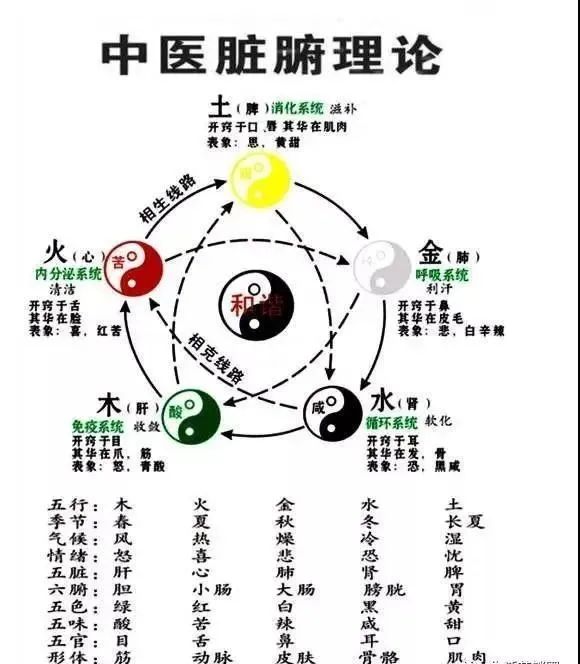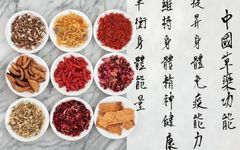
Follow us for lifelong benefits!
The human body contains a total of five organs and six bowels. The five organs are: Xin (Heart), Gan (Liver), Pi (Spleen), Fei (Lung), and Shen (Kidney); the six bowels refer to the Dan (Gallbladder), Wei (Stomach), Da Chang (Large Intestine), Xiao Chang (Small Intestine), San Jiao (Triple Burner), and Pang Guang (Bladder).
The primary function of the five organs is to store essence and qi; the main physiological function of the six bowels is to receive, digest food, separate clear from turbid, transform essence, and expel waste from the body without retention.

Relationship Between the Five Organs and Health Preservation
For any issue related to Jin (tendons), treating the Gan (Liver) is appropriate.
For any issue related to Gu (bones), treating the Shen (Kidney) is appropriate.
For any issue related to Ji Rou (muscles), treating the Pi Wei (Spleen and Stomach) is appropriate.
For any issue related to Xue Mai (blood vessels), treating the Xin (Heart) is appropriate.
For any issue related to Pi Fu (skin and hair), treating the Fei (Lung) is appropriate.
Main Functions of the Five Organs
1. Xin (Heart):
It governs blood vessels and houses the spirit. Due to the Heart’s role in governing blood vessels and housing the spirit, it is referred to as the “Ruler’s Organ,” “Source of Life,” and “Supreme Organ of the Five Organs and Six Bowels.” The physiological characteristic of the Heart is that it is a Yang organ and governs clarity.
The Heart is associated with the vessels, its manifestation is on the face, its orifice is the tongue, its emotion is joy, and its fluid is sweat. The Hand Shaoyin Heart Meridian and the Hand Taiyang Small Intestine Meridian are interconnected with the Heart and Small Intestine, representing interior and exterior. The Heart belongs to the Fire element in the Five Elements, corresponding to the summer energy of nature.
2. Fei (Lung):
It governs qi and respiration, regulates water, and connects to all vessels, governing the regulation of the body. The basic operational form of Lung qi is to disperse and descend. The Lung is positioned highest among the five organs and covers all organs, hence it is called the “Canopy.” The Lung is delicate and vulnerable to cold, heat, dryness, and dampness; it also connects to the nasal orifices and the skin, making it susceptible to external pathogens, thus it is referred to as the “Delicate Organ.”
The Lung is associated with the skin, its manifestation is in hair, its orifice is the nose, its emotion is grief (sorrow), and its fluid is mucus. The Hand Taiyin Lung Meridian and the Hand Yangming Large Intestine Meridian are interconnected with the Lung and Large Intestine, representing interior and exterior. The Lung belongs to the Metal element in the Five Elements, corresponding to the autumn energy of nature.

3. Pi (Spleen):
It governs transformation and transportation, and oversees blood. The Spleen and Stomach reside in the middle jiao, serving as the primary organs for the digestion, absorption, and distribution of food essence. After birth, the continuation of life activities and the generation and replenishment of essence, blood, and fluids rely on the Spleen and Stomach’s transformation of food essence, hence they are referred to as the “Foundation of Postnatal Life.” The movement characteristic of Spleen qi is to ascend and raise. The Spleen is associated with the Taiyin damp earth and governs the transformation of fluids, thus it prefers dryness and dislikes dampness.
The Spleen is associated with muscles and governs the four limbs, its orifice is the mouth, its manifestation is in the lips, its emotion is thought, and its fluid is saliva. The Foot Taiyin Spleen Meridian and the Foot Yangming Stomach Meridian are interconnected with the Spleen and Stomach, representing interior and exterior. The Spleen belongs to the Earth element in the Five Elements, corresponding to the extreme Yin of Yin, and is active in all seasons.
4. Gan (Liver):
It governs the smooth flow of qi and stores blood. The “Liver Wind” in the “Clinical Guidelines” states that the Liver is “Yin in form but Yang in function.” The physiological characteristic of the Liver is to promote upward movement, favoring smoothness and disliking stagnation, hence it is called the “Sturdy Organ.” The “Su Wen: Ling Lan Mi Dian Lun” states: “The Liver is the official of the general, from which strategies arise.”
The Liver is associated with tendons, its manifestation is in the nails, its orifice is the eyes, its emotion is anger, and its fluid is tears. The Gallbladder is attached to the Liver, and the Foot Jueyin Liver Meridian and the Foot Shaoyang Gallbladder Meridian are interconnected with the Liver and Gallbladder, representing interior and exterior. The Liver belongs to the Wood element in the Five Elements, corresponding to the Yang within Yin, and is connected to the spring energy of nature.
5. Shen (Kidney):
It stores essence, governs water, and regulates qi. As the Kidney stores congenital essence and governs reproduction, it is referred to as the “Source of Congenital Life.” Kidney essence transforms into Kidney qi, which differentiates Yin and Yang, and Kidney Yin and Yang support, promote, and coordinate the Yin and Yang of all organs, hence the Kidney is also called the “Foundation of the Yin and Yang of the Five Organs.” The Kidney stores essence and governs hibernation, also known as the “Foundation of Storage.”
The Kidney is associated with bones, produces marrow, connects to the brain, its manifestation is in hair, its orifice is the ears and the two Yin, its emotion is fear, and its fluid is saliva. The Foot Shaoyin Kidney Meridian and the Foot Taiyang Bladder Meridian are interconnected with the Kidney and Bladder, representing interior and exterior. The Kidney belongs to the Water element in the Five Elements, corresponding to the extreme Yin of Yin, and is connected to the winter energy of nature.
Interrelationships of the Five Organs
(1) A strong Kidney strengthens the Liver.
A well-functioning Kidney enhances detoxification, reducing the Liver’s detoxification burden, thus the Liver becomes stronger.
(2) A strong Liver strengthens the Heart.
A well-functioning Liver enhances detoxification, improving blood quality, reducing the Heart’s burden, thus the Heart becomes stronger.
(3) A strong Heart strengthens the Stomach.
A strong Heart enhances blood supply, improving blood circulation, thus the mucosal tissues of the gastrointestinal tract receive better blood circulation, and the gastrointestinal function becomes stronger.
(4) A strong Stomach strengthens the Lung.
A well-functioning Stomach improves digestion and absorption, normalizing the Spleen’s function, thus the Large Intestine’s excretion becomes smooth, and the Lung function becomes stronger.
(5) A strong Lung strengthens the Kidney.
A well-functioning Lung improves Large Intestine excretion, reducing the Kidney’s detoxification burden, thus the Bladder operates normally, and the Kidney function gradually enhances.
Conflicts Among the Five Organs
(1) A weak Kidney weakens the Heart.
Poor Kidney function leads to poor detoxification, resulting in poor blood quality, increasing the burden on the Heart, thus the Heart function weakens.
(2) A weak Heart weakens the Lung.
Poor Heart function leads to poor oxygen transport in the blood, resulting in poor gas exchange in the Lung, thus Lung function weakens.
(3) A weak Lung weakens the Liver.
Poor Lung function leads to poor Large Intestine excretion, causing excessive toxin retention, increasing the Liver’s detoxification burden, thus Liver function gradually weakens.
(4) A weak Liver weakens the Stomach.
Poor Liver detoxification function leads to abnormal bile secretion, affecting food breakdown, thus Stomach digestion weakens.
(5) A weak Stomach weakens the Kidney.
Poor Spleen and Stomach function reduces the Spleen’s ability to act as a waste transfer station.
Relationship Between the Five Organs and the Five Spirits
Five Spirits: Hun (ethereal soul), Shen (spirit), Yi (intellect), Po (corporeal soul), Zhi (will).
The five organs store: the Liver stores Hun, the Heart stores Shen, the Spleen stores Yi, the Lung stores Po, and the Kidney stores Zhi (“Su Wen: Xuan Ming Wu Qi Pian”). The five organs also generate five emotions: the Heart corresponds to joy, the Liver to anger, the Spleen to thought, the Lung to grief, and the Kidney to fear. These five emotions develop into the seven emotions of joy, anger, grief, thought, worry, fear, and shock.
Relationship Between the Five Organs and the Five Fluids
Five Fluids: Tears, sweat, saliva, mucus, and spittle.
“Su Wen: Xuan Ming Wu Qi Pian” states, “The five organs transform into five fluids: the Heart corresponds to sweat, the Lung to mucus, the Liver to tears, the Spleen to saliva, and the Kidney to spittle, which are called the five fluids.
Relationship Between the Five Organs and the Five Orifices
The Liver opens to the eyes, tears flow from the eyes, hence “Su Wen: Xuan Ming Wu Qi Pian” states: the Liver corresponds to tears. Tears have the function of moistening and protecting the eyes.
The Heart opens to the tongue, indicating that the tongue is the external representative of the Heart, also known as the “Sprout of the Heart.” The tongue’s function is to govern taste and express language, thus “Ling Shu: You Huai Wu Yan” states: the tongue is the mechanism of sound.
The Spleen opens to the mouth, the oral cavity is the uppermost part of the digestive tract. Opening to the mouth indicates that the taste of food is closely related to the Spleen’s transformation function. The normalcy of taste relies on the Spleen and Stomach’s transformation function, which is the normal ascent of the Spleen and descent of the Stomach.
The Lung opens to the nose, the nose and throat connect to the Lung, making the nose and throat the gateways of respiration, hence the saying “the nose is the orifice of the Lung, and the throat is the portal of the Lung.”
The relationship between the ears and saliva is that the Kidney opens to the ears, and the Kidney corresponds to spittle!
Relationship Between the Five Organs and the Five Tastes
Bitter enters the Heart, sour enters the Liver, sweet enters the Spleen, pungent enters the Lung, and salty enters the Kidney.
Traditional Chinese Medicine theory holds that each type of food has its specific properties and flavors, which have different effects and benefits on the body. Zhen Yue Food Medical has specially developed various functional soups and nourishing waters based on TCM principles, tailored to the physical needs of different populations, according to the correspondence and nourishing methods of the five senses, five colors, five tastes, and five organs to better assist in your health management. Different soups are prepared using various flavored ingredients, resulting in different flavored soups such as sour, sweet, and bitter, which can better maintain the body’s functions in optimal condition.
Relationship Between the Six Bowels and Health Preservation
1. Dan (Gallbladder): known as the official of decision-making.
Physiological function: stores and excretes bile, the Gallbladder governs decision-making.
2. Wei (Stomach): known as the official of storage, when Stomach fire is strong, hunger is quick, and upper tooth pain corresponds to the Stomach Meridian, Neiting point;
Physiological function: receives and digests food, the Stomach descends to harmonize.
3. Xiao Chang (Small Intestine): the official of receiving and transforming essence;
Physiological function: governs receiving and transforming substances, separating clear from turbid, “the Small Intestine governs fluids.”
4. Da Chang (Large Intestine): the official of transmission, excreting waste, lower tooth pain corresponds to the Large Intestine Meridian, Hegu point, and Jiache point.
Physiological function: transforms waste, the Large Intestine governs fluids.
5. Pang Guang (Bladder): the official of storage and qi transformation.
Physiological function: stores and excretes urine, relying on the Kidney’s qi transformation function.
6. San Jiao (Triple Burner): the official of regulation, governing the pathways of water, overseeing the five organs and six bowels and internal and external pathways;
Physiological function: facilitates the flow of original qi, oversees qi mechanisms and transformations, and serves as the pathway for fluid movement.
From the interrelationships of the organs in the human body, it can be seen that no organ exists in isolation. The health and strength of one organ can positively influence other organs, while the dysfunction of one organ can adversely affect others.
Therefore, health is a state of appropriate balance among the relative components within the body. If any function is particularly prominent or deficient, disrupting harmony, it can lead to disease.
Disclaimer:The platform aims to promote and enhance Traditional Chinese Medicine. If there are any objections to the reprinted articles, please contact us for removal.

Scan to follow and receive secret recipes
For medical inquiries, add WeChat
w13898988853

